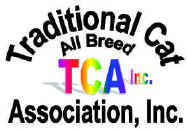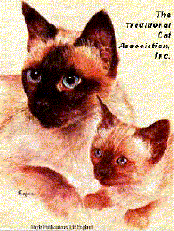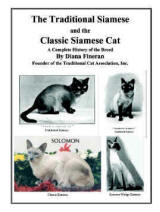Our
newsletter has been published continuously since 1987. It is a tribute to the
efforts of many contributors. So as not to forget their efforts, and the
value of their words, we have provided a look back at some of the issues for
your enjoyment and review.
 Spay/Neuter
Stamp
Spay/Neuter
Stamp
 Coat
Texture
Coat
Texture
 Chantilly/Tiffany
- Breed Update
Chantilly/Tiffany
- Breed Update
 Our
Resident Poet
Our
Resident Poet
 Kitten
Proofing Your House
Kitten
Proofing Your House
 "TYPE"
- An Explanation
"TYPE"
- An Explanation
 International
Updates
International
Updates
 The Thai
The Thai
Links to past articles:
Introducing the
Bengal Cat
Purpose of the Bengal Cat League
Bengal Cat Ancestry
"...thanks for such a great
newsletter!" (Deanne)
PASSAGE OF THE SPAY/NEUTER STAMP PENDING
Published with permission from Humane Society
News and from Spay USA Network News.
"The U.S. Postal Serviceís Citizenís Stamp
Advisory Committee (CSAC) met in early October to consider the proposal for a
commemorative stamp urging pet owners to "Spay or Neuter-Save A Life". Since the
campaign was launched in September of 1997, the CSAC has received thousands of
letters from humane groups, veterinary medical associations and colleges, and
also celebrities (including Bob Barker, Betty White, Tony LaRussa, and Olympic
tri-athalete Eric Harr). At the conclusion of Octoberís meeting, supporters of
the Spay-Neuter stamp had reason to celebrate! Of more than 7000 stamp requests,
this stamp was one of just 200 that will be up for consideration in the year
2,000. To lend your support you can write to: Dr. Virginia Noelke, Chair,
Citizenís Stamp Advisory Committee, United States Postal Service, 475 LíEnfant
Plaza, SW, Room 4474E, Washington, DC 20260-2437."
Back to
top
COAT TEXTURE
by Diana Fineran
Did you know that the Traditional Siamese and
Classic Siamese coat is not the FLAT pressed down coat that the Extreme Wedge
Siamese has? The Traditional types have a sort of fluffy coat, but not as long
as the Balinese, of course. It has texture, thickness and spring to it, yet it
is still a short hair length. Some of our customers have asked about this after
visiting an Extreme Wedge breeder and then going to a Traditional or Classic
breeder. I just wanted to clarify that there is a difference in coat.
Back to
top
REPORT
ON THE CHANTILLY/TIFFANY
From Tracy Oraas
There are many good reports coming from the
direction of the Chantilly/Tiffany. This is one of the breeds accepted by TCA,
Inc. First of all they have attained additional Championship Status in UFO,
where several cats have attained Championships. Sweetables Cattery in Chicago
has a Double Champion! George and Tracy have exported breeding stock to Mr.
Deboer in the Netherlands recently. They are being shown in Holland and being
well received. In July a German Magazine based in L.A. sent a photographer to
Canada to do a photo shoot for an article, using Tracyís cats. Unfortunately the
article is written in German, or I would be asking to reproduce it here!! Two
new cat Encyclopedias included the Chantilly/Tiffany along with lovely photos.
One is authored by Ann Helgrin, who chose a photo of a black ticked
Chantilly/Tiffany owned by Tracy. This is one of only two cats with this very
rare color. The second cat Encyclopedia was authored by Bruce Fogle, which
included comparisons with the British Burmilla. The difference started in 1982
when the British crossed a Burmese with a Chinchilla Persian and began calling
the resulting cross a "Tiffanie". The similarity in breed names has caused TICA
to ask our Chantilly/Tiffany breeders to change their breed name! At least the
comparison is begin presented, so all can make their own decision. All are
lovely cats. George and Tracy are always looking for breeders to work with. They
are listed on our Breeders List.
Back to
top
FROM OUR RESIDENT POET
"LETTER TO A CAT"
by F.W. "Al" Albers
12-7-98
Ah, soft-walking Queen of the Night,
Sleek, black-furred, with eyes so bright;
How often Iíve yearned to talk with you,
But itís not given me as a thing I can do..
Like a living shadow you go your way,
Thru the dusk of evening to return of day.
Where have you gone? What have you seen?
Was your night-tour happy? Was it all serene?
Have you learned the fate of Johnsonís dog? Or
Who broke the fence around Bergen bog?
But of course we know that you pay no mind
To the trivial things of human kind.
Still, I know right now that day after day,
I would sure like to hear what I feel you could say!
Back to
top
KITTEN PROOFING YOUR HOUSE
Reprinted with permission from PetAid League From their Autumn 1998
issue, page 5.
"Kittens are curious creatures capable of
jumping onto high surfaces or squeezing into the smallest of spaces. To protect
your kitten in his new environment, and to safeguard your belongings,
kitten-proof your house. KITCHENS/BATHROOMS: # Use childproof latches to keep
little paws from prying open cabinets. # Keep trash cans covered or inside a
latched cabinet. # Check for a block any small spaces, nooks, or holes inside
cabinetry or behind washer/dryer units. # Make sure your kitten hasnít jumped
into the dryer before you turn it on. # Keep foods out of reach (even if the
food isnít harmful, the wrapper could be). LIVING/FAMILY ROOM: # Place dangling
wires from lamps, VCRís, stereos, and phones out of reach. # Keep kidsí toys put
away. # Put away knick-knacks until your kitten has the coordination not to
knock them over. # Check all those places where your vacuum cleaner doesnít fit,
but your kitten does, for dangerous items, like string. # Move house plants,
which can be poisonous, out of reach, including hanging plants that can be
jumped onto from other nearby surfaces. #Be careful that you donít close your
kitten in closets or dresser drawers. # Make sure all heating/air vents have
covers. # Put away all sewing and craft notions, especially thread. GARAGE: #
Move all chemicals to high shelves or behind secure doors. #Clean up all
antifreeze from the floor and driveway, as one taste can be lethal to a kitten.
# Bang on your car hood to ensure that your kitten (or any neighbor cat) has not
hidden in the engine for warmth. BEDROOMS: # Keep laundry and shoes behind
closed doors (drawstrings and buttons can cause major problems. # Keep any
medication, lotions, or cosmetics off accessible surfaces (like the beside
table). # Move electrical and phone wires out of reach of chewing."
Back to
top
A QUESTION OF TYPE
By Shelagh LeCocq
Shelagh LeCocq is the founder of our sister club
in Great Britain and publishes their Newsletter. Iím grateful to receive her
permission to use this article she wrote on type.
"Type describes the physical appearance and
genetic components which allow one cat to be identified as a Siamese, and
another cat as Persian. It also enables cats of differing colours within a breed
to clearly be identified as individuals with the same phenotype."
"Yet type is not a fixed and immutable
characteristic. If pictures of Persians and Siamese from the early part of the
century are compared with todayís specimens, distinct differences can be seen
and there has been much debate around whether these changes are an improvement
or not."
"So why do changes in type occur? Genetic drift
and mutation within a species is a normal occurrence and such changes have
resulted in the development of breeds such as the Rex, Devon and Cornish. Some
mutations confer a biological advantage to a species, and in a natural
environment that type will eventually predominate. When show and breeding
animals are concerned, a particular specimen may dominate the breed during his
or her lifetime and, if used extensively, will produce a generation of like
cats."
"A subtle change that develops in a breed may
become fixed and accentuated with certain characteristics being dominant. The
change in head shape of Siamese clearly demonstrates this. For a change in type
to become well established, breeders and judges have to see this a desirable and
the breed standard my be modified as required by the Breed Advisory Council."
(Breed Standards in TCA, Inc. are not allowed to be changed.)
"With current debate in the cat and dog world
concerning the health and viability of pedigree animals, it is worth considering
how such changes develop in more detail. Few breeders have an image of how the
breed changes. More often than not, it is the show successes of individual cats
or dogs that establish a winning type, which is sought by other breeders. Health
and viability may be secondary considerations and so certain breeds my develop
"problems"." Heart problems have been identified in Boxers, umbilical hernias
are common in several breeds of dog. Advisory Councils have an important role in
monitoring changes in type, temperament and health within their breed. Their
duties should not only be to promote show success, but also to maintain some
system of ensuring that a breed remains sound. Perhaps breed policy should
consider the effects of population in breeding, which will occur when one or
more males dominates a generation. These issues are certainly debated in Europe
with regard to certain breeds of dog."
"Breeders are fortunate if most of their kittens
find good homes as companion animals. Show homes are a bonus for a very few.
Changes in type should encompass the image of the cat as a healthy and viable
pet. I consider myself fortunate in being able to develop a breeding programme
with my cats, which has allowed me to work with new sex-linked colours, but in
doing so I have tried to maintain the type and temperament which allows those
kittens who leave to become much loved pets with their new families."
http://members.tripod.com/tsca.uk/
Back to top
INTERNATIONAL UPDATES
FROM HUNGARY: Heiner Karolyne has
written that she has lost her stud male, Furedi Anti-Kacor, who was one of the
very first European Traditional Siamese Champions. She writes, " I was planning
to write to you for some time. I have very sorrowful news, which makes me to
postpone my letter. I have lost my beautiful cat, Kacor on May 24, 1998. I was
very painful and I will miss him for a very long time. I have his son (6 years
old), but he is different, but he comforts me. I will remember and show my grand
children what a precious cat Kacor was. Kacor was the nephew of Dr. Laszlo
Tothís cat "Dixi-XiXi. He had a very distinctive form of the old-type Siamese
cats."
Dr. Toth also sent such a pleasant message, I
have to share it with you. "I hope my letter will find you in good health. I
would like to enclose our magazine where your letter and article were published.
The members of our club liked the article very much. We are preparing the next
year at the moment. We would like to arrange an exhibition 27thFebruary
1999. We hope that we could arrange an exhibition together with Your Club. This
way you could combine a nice tour to Budapest with an exhibition. I would like
to wish you Merry Christmas and very happy New Year and very much success in
your work."
To my humble amazement on page 7 of her color
Newsletter was published my cover letter and my article describing the three
types of Siamese, translated to Hungarian! Thank you for such an honor, Dr.
Toth! The message is getting out world wide, adding much scope to our mutual
efforts, and that is so satisfying. Take a look at their magazine:
http://macskamagazin.budapestnet.hu/index.html
In the same newsletter was an article about the
continuing world travels of Dr. Toth and her family with her Traditional Siamese
cat XIXI, who always goes on vacations with them. Glorious color pictures show
XIXI sitting on a covered cushion on top of their car roof in a light leather
harness with a leash. In the background are sun-bathed temples, palaces and
ancient buildings recognized worldwide. Even though the article is written in
Hungarian, I was able to pick out the names of some of the places....Xombor,
Belgrade, Nice, Macedonia, Thebes, Athens, Crete, Cyprus, Israel, Haifa, Jordan,
Nazareth, Hedera, Telavia, Fajja, Jerusalem, Judea, Casablanca, Akaba, The
Egyptian pyramids, Sinai, Suez canal, Cairo, Alexandria, Giza, Memphis, and
Luxor. Each photo was made so much more exotic with XIXI sitting in the
foreground. What an adventurous family, and truly an intrepid Traditional
Siamese!
FROM HOLLAND via the Newsletter of
our sister club in England: Ineke
Blokker presented an excellent report of the 41stInternational
Exhibition
"Katten Kijken Ď99" Holland held on January 24th. Here are excerpts
from her report, "1003 cats were at the show. Nineteen Traditional Siamese cats
came to the show, which was a surprise for the Dutch organization. It was the
first time they had to admit to recognize this Siamese cat as different from the
modern Siamese and bring a specialist. They had invited a German judge to
examine this type. In Germany they have already accepted the Traditional Siamese
as "Thai" and they use the written standard of FFEe.V. (Feline Federation
Europe). Nine of the Traditional Siamese cats came from Germany. When the
visitors were allowed in we did non-stop talking about our cats. Most were very
surprised to see the "old fashioned" Siamese cat back on the show. They were
very positive and sometimes deeply touched to recognize their own cat, passed
away for many years. Eighteen Traditional Siamese cats got a "U" at this show
(U=excellent animal for exhibitions and breeding). And for the first time I have
seen two Traditional Siamese getting their prize on the platform for
Best-Of-Variety and CACIB (Certificat dí Aplitude au Championnat Internationa de
Beaute)."
Back to
top
|

 The
Traditional Cat Association,
Inc.©1987ģTM
Official Website
The
Traditional Cat Association,
Inc.©1987ģTM
Official Website